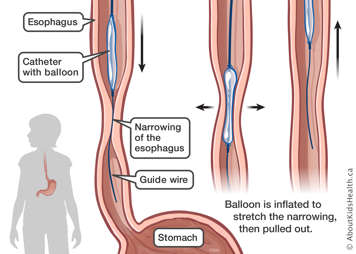What is esophageal dilatation?

The esophagus is the tube that carries food and liquid from the mouth to the stomach. Some children have difficulty swallowing due to narrowing or tightening of their esophagus (called esophageal stricture). Esophageal dilatation is a procedure in which a tiny balloon is inflated inside the esophagus to stretch or open the narrow areas. Often esophageal dilatation is done using image guidance (using X-rays to see inside the body) by an interventional radiologist.
How an esophageal dilatation is done
Esophageal dilatation is performed by an interventional radiologist, or sometimes a gastroenterologist. The doctor uses an X-ray dye, called contrast dye, to see the area of the esophagus that is narrowed. The doctor then inserts a tiny soft wire, and a catheter with a balloon, into this area. The balloon is then inflated in the esophagus, stretching the narrowed section of the esophagus. The doctor then injects contrast in the esophagus to check for any leaks.
Esophageal dilatation usually takes one hour.
Risks of esophageal dilatation for your child
Esophageal dilatations are generally considered to be low-risk procedures. Risks may increase depending on your child’s condition, age, and health.
The risks of an esophageal dilatation can include:
- pain in the chest, neck or back
- hoarseness
- difficulties swallowing
- aspiration into the lungs
- infection in the chest or belly
- coughing and throwing up blood
- esophageal perforation (hole or tear in the esophagus)
Giving consent before a procedure
Before the procedure, the interventional radiologist will go over how and why the procedure is done, as well as the potential benefits and risks. They will also discuss what will be done to reduce these risks and they will help you weigh any benefits against the risks. It is important that you understand all the potential risks and benefits of an esophageal dilatation and that all your questions are answered. If you agree to the procedure, you can give consent for the procedure by signing the consent form. A parent or legal guardian must sign the consent form for young children. The procedure will not be done unless you give your consent.
How to prepare your child for the procedure
Before any treatment, it is important to talk to your child about what will happen. When talking to your child, use words they can understand. Let your child know that medicines will be given to make them feel comfortable during the procedure.
Children feel less anxious and scared when they know what to expect. Children also feel less worried when they see their parents are calm and supportive.
If your child becomes ill within two days before the procedure
It is important that your child is healthy on the day of the procedure. If your child starts to feel unwell or has a cold or a fever within two days before the procedure, let your doctor know. Your child’s procedure may need to be rescheduled.
Food, drink, and medicines before the procedure
- Your child’s stomach must be empty before receiving a general anaesthetic.
- If your child has special needs during fasting, talk to your doctor to make a plan.
- Your child can take their regular morning medicine with a sip of water two hours before the procedure.
- Medicines such as acetylsalicylic acid (ASA), naproxen or ibuprofen, warfarin, or enoxaparin may increase the risk of bleeding. Do not give these to your child before the procedure unless they have been cleared by your child’s doctor and the interventional radiologist.
On the day of the procedure
Arrive at the hospital two hours before the planned time of your child’s procedure. Once you are checked in, your child will be dressed in a hospital gown, weighed and assessed by a nurse. You will also be able to speak to the interventional radiologist who will be doing the esophageal dilatation and the anaesthetist who will be giving your child medication to make them comfortable for the procedure.
During the procedure you will be asked to wait in the surgical waiting room.
Your child will have medicine for pain
It is important that your child is as comfortable as possible for the procedure. Your child will need general anaesthesia for this procedure.
After the esophageal dilatation
Once the esophageal dilatation is complete, your child will be moved to the recovery area. The Interventional Radiologist will come and talk to you about the details of the procedure. As soon as your child starts to wake up, a nurse will come and get you.
Going home
Most children who have an esophageal dilatation go home the same day. Your child will be ready to go home about six to eight hours after the procedure. Occasionally some children will stay overnight after the procedure for observation.
For more details on how to care for your child after the procedure, see Esophageal dilatation: Caring for your child at home after the procedure.
At SickKids
If you have any concerns in the first 48 hours, call the Image Guided Therapy (IGT) clinic at (416) 813- 7654 ext. 201804. Speak to the IGT clinic nurse during working hours or leave a non-urgent message.
If you have concerns and it is after working hours, see your primary care provider or go to the nearest Emergency Department. You can also call the Hospital for Sick Children switchboard at (416) 813-7500 and ask them to page a member of your child’s health-care team or the interventional radiology fellow on call.
For more information on fasting see Eating and drinking before surgery.
For more information on preparing your child for their procedure see Coming for surgery.